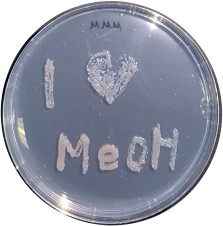Methylotrophy and one-carbon metabolism

Methylotrophy describes the ability of organisms to grow solely on reduced substrates containing no carbon-carbon bonds (C1-compounds). Such compounds include for example methanol (CH3OH), methane (CH4), or methylamine (CH3NH2). Methylotrophs can be found in all domains of life; however, my interest lies primarily in bacterial methylotrophy.
Methylotrophs face the challenge of generating their entire biomass as well as all their energy needs (reducing equivalents/ATP) from these small C1-compounds. Hence, every C–C bond has to be formed from scratch. One-carbon metabolism thus plays an essential role in methylotrophs. In bacteria, several coenzymes can serve as so-called C1-carriers (Vorholt, Arch. Microbiol., 2002). These coenzymes include tetrahydrofolate (H4F), tetrahydromethanopterin (H4MPT), glutathione (GSH), or methylofuran (MYFR). Their role is to covalently bind the one-carbon units (using an amine or thiol functionality) to facilitate conversion and oxidation.
During my PhD, one of my research interests was the structure and function of the C1-carrier methylofuran, a coenzyme that remained unidentified in bacteria for a long time.
Methylofuran: a large coenzyme involved in formaldehyde oxidation
Methylofuran is an essential coenzyme in many bacterial methylotrophs as it is required in the H4MPT-dependent pathway for formaldehyde oxidation. In methanogens (archaea that are able to grow on H2 and CO2 by producing CH4), a structurally and functionally analogous coenzyme has been known previously and is termed methanofuran (Leigh et al., JACS, 1984; Allen & White, Biochemistry, 2014). Although genetic and biochemical evidence suggested that methylofuran would be similar to methanofuran (Chistoserdova et al., Science, 1998), extraction and analysis of the coenzyme remained challenging.
In my PhD, I thus set out to identify and characterize methylofuran from the methylotrophic model strain Methylorubrum extorquens. Using LC-MS/MS, NMR, and isotopic labeling experiments, we were able to determine the structure of methylofuran (Hemmann et al., JBC, 2016). The core structure of methylofuran is similar to the one of methanofuran, but in place of the tyramine residue, MYFR harbors a tyrosine moiety. Surprisingly, however, a large polyglutamate side chain with a distribution of 12 up to 24 glutamate residues is attached to the core structure. With masses up to 3.4 kDa, methylofuran is the largest known coenzyme! Using NMR, we further determined that the glutamates are connected via both α- and γ-linkages, another feature not found in methanofurans.

Methylofuran as a prosthetic group of the formyltransferase/hydrolase complex (Fhc)
The discovery of the large polyglutamate side chain attached to methylofuran was surprising and its role was initially very puzzling. To further investigate its function, we had a closer look at the formyltransferase/hydrolase complex (Fhc), the enzyme that requires methylofuran as a coenzyme (Pomper & Vorholt, Eur. J. Biochem., 2001; Pomper et al., FEBS Letters, 2002). Fhc is a bifunctional enzyme and catalyzes the following two reactions:
formyl-H4MPT + MYFR ↔︎ formyl-MYFR + H4MPT
formyl-MYFR + H2O ↔︎ MYFR + formic acid
Thus, Fhc hydrolyzes the H4MPT-bound formyl group (which originates from formaldehyde) to formate by using methylofuran as an intermediate formyl carrier. The two reactions are catalyzed at separate active sites and involve different subunits of the tetrameric Fhc.

To learn more about the interaction between methylofuran and Fhc, we purified the enzyme from M. extorquens and characterized it in vitro. Intriguingly, methylofuran turned out to be a non-covalently bound prosthetic group of Fhc that remains bound during purification of the enzyme. In collaboration with Dr. Tristan Wagner (MPI Bremen) and Dr. Seigo Shima (MPI Marburg) we solved the crystal structure of Fhc in complex with methylofuran in order to determine the molecular basis of this interaction.
The crystal structure (PDB ID 6S6Y) revealed that the binding site of methylofuran is centrally located between the two active sites of Fhc (Hemmann et al., PNAS, 2019). Unexpectedly, the electron density further suggested that the polyglutamate chain is branched (i.e. having isopeptide bonds involving the side chain carboxylic acids), allowing for tight interactions of the negatively charged glutamates with the positively charged surface of Fhc (due to the presence of many arginines and lysines). This binding mode suggests that the polyglutamate chain additionally functions as a flexible linker that is able to reach both active sites. We thus propose that methylofuran shuttles formyl units from the site for formyl transfer (FhcD) to the site for formyl hydrolysis (FhcA) through a swinging motion. During this cyclic process, methylofuran never has to dissociate from the enzyme, thus enabling efficient catalysis and preventing the need of a high coenzyme pool.

Structural diversity and biosynthesis of methylofuran
In a recent part of my research (Hemmann et al., JBC, 2021), I investigated whether the structure of methylofuran identified in M. extorquens is conserved in other methylotrophic bacteria. To that end, we analyzed several proteobacterial strains carrying genes for MYFR biosynthesis. Our LC-MS analysis revealed that only a few strains produced the known MYFR from M. extorquens. In most of the bacteria, we identified a novel derivative of MYFR, MYFRTyramine, that contains a tyramine moiety instead of the tyrosine found in the classical MYFRTyrosine.

We then continued to investigate the biosynthesis of MYFR, focusing on the incorporation of tyrosine/tyramine and on the formation of the polyglutamate side chain. Using gene deletions, LC-MS analysis of MYFR intermediates, enzyme purification, and in vitro assays, we identified two enzymes involved in the biosynthesis of the polyglutamate chain. MyfA (OrfY) seems to add the second glutamate to the MYFR core containing already one glutamate. This intermediate can then be further elongated by MyfB (Orf5), an enzyme that is strongly binding to MYFR in vivo. In vitro assays with purified MyfB revealed glutamate ligase activity, as the enzyme was able to form polyglutamates consisting of 2 up to 11 units from glutamate. Interestingly, both L- and D-glutamate were accepted as substrate, raising the question if MYFR might also contain both enantiomers of glutamate.
